From the Great Pyramids of Ancient Egypt to the tallest skyscraper in the world, DubaiÔÇÖs Burj Khalifa, humans have always pushed the boundaries of what is possible in engineering.
As technology has developed, new materials have been discovered and our understanding of forces has improved, weÔÇÖve been able to build bigger, higher and stronger.
┤¾¤¾┤½├¢ Bitesize takes a look at some of the most amazing bridges, tunnels and canals to have been built since the start of the 20th Century.
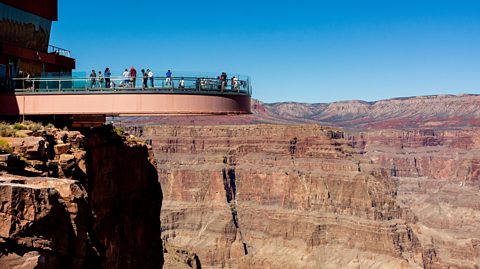 Image source, Alisa_Ch
Image source, Alisa_ChThe Grand Canyon Skywalk, US
Suspended over 4,000 ft (1219 m) above the Colorado River, the Grand Canyon Skywalk offers brave visitors the chance to step over the edge and peer at the drop beneath their feet. Owned by the Hualapai tribe, on whose land it is located in Arizona, this U-shaped glass walkway extends out from the rock by about 70 ft (21 m). The glass itself is 2.8 inches (7 cm) thick.
But how can the structure support its own A force that acts on mass, pulling it down, due to gravity. Weight is a force and forces are measured in newtons (N). and those walking on it, without reinforcement from underneath? The answer lies in cantilever engineering. A cantilever is a beam, typically made of steel or concrete, which is only supported on one end but is able to carry a load on the other end. When weight is applied to the unsupported end, the force is directed towards the fixed end. The beams which form the Grand Canyon Skywalk extend backwards 45 ft (13.7 m) into the red limestone The solid rock below any loose surface material, such as soil., still firmly anchoring it in place.
Engineers also had to take into account the vibrations caused by both wind and people walking, jumping and running on the walkway. A mechanism called a tuned mass damper was added to counteract any unwanted movement, ensuring that pedestrians experience no discernible discomfort.
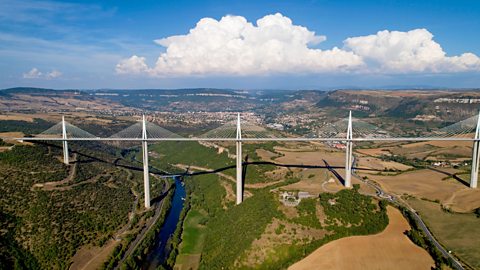 Image source, Valery Inglebert / 500px
Image source, Valery Inglebert / 500pxMillau Viaduct, France
Rising up out of the Tarn Valley in FranceÔÇÖs Massif Central mountains, the Millau Viaduct is the tallest road bridge in the world. The tallest of its seven piers soars 245 m (804 ft) into the sky. Designed by the famous British architect Norman Foster, it was inaugurated on 14 December 2004 by the then French President Jacques Chirac.
The Millau Viaduct was built to divert vehicles away from the town of Millau, which had become a traffic bottleneck, as well as to complete the A75 autoroute connecting Paris to the Mediterranean coast.
Each section of the road deck is 342 m (1122 ft) long and could not be simply lifted and craned into position. Instead, the prefabricated sections were slowly inched outwards from the piers at an average speed of 9 m/h. In total, the road deck weighs 36,000 tonnes.
Taking into account that the road deck would expand and contract depending on the weather, the supporting concrete piers actually split into two slimmer columns that are able to flex.
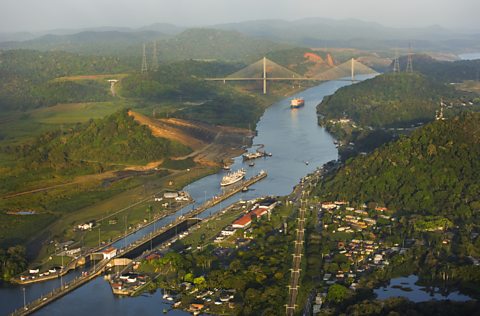 Image source, Danny Lehman
Image source, Danny LehmanPanama Canal, Panama
Connecting the Atlantic and Pacific Ocean, the Panama Canal is one of the most important waterways in the world. At around 40 miles (65 km) long, it cuts approximately 8,000 nautical miles (15,000 km) off a shipÔÇÖs journey between the east and west coasts of the US.
Built by the US, work on the canal was completed in 1914 and from then until 1979, the US had sole control over it. It was only at midday on 31 December 1999 that complete control was handed over to Panama itself.
Like many smaller canals that you might see in the UK, the Panama Canal uses a lock system to raise up and lower ships as the surrounding water levels require. 3.4 million cubic metres of concrete were required to build the locks. In order to allow two vessels to travel in opposite directions without holding each other up, the locks of the Panama Canal were actually built in pairs and are electrically powered.
In 1970, 15,523 vessels passed through the Panama Canal, its highest ever number. However, although the number of ships traversing the canal has since decreased, their cargo-carrying capabilities have only improved. In 2013, 213 million metric tons of cargo was shipped along the canal.
 Image source, Danny Lehman
Image source, Danny Lehman Image source, William Lovelace
Image source, William LovelaceChannel Tunnel, UK/France
Also known as the Eurotunnel, this 31 mile (50 km) rail tunnel runs beneath the English Channel between Folkestone in England and Calais in France. Of that length, 23.5 miles (37.8 km) is undersea, which is the longest distance in the world. It officially opened on 6 May 1994.
The Channel Tunnel is actually made up of three tunnels. Two of the tunnels are for rail services travelling in opposing directions and there is a third central tunnel for security and services.
In building the Channel Tunnel, 11 huge tunnel-boring machines were required. One of them is still buried down there, having been deemed too large to remove. All the material they excavated had to go somewhere, which is how 4.9 million cubic metres of chalk marl and shale (types of rock) helped to create the Samphire Hoe nature reserve in Dover and a hill at Le Fond Pignon in France.
When travelling through the tunnel, passengers have the option of taking their car with them by driving it into specially designed carriages. No vehicle? Then you simply book a train ticket. Either way, the trip itself takes around 35 minutes with the train able to reach speeds of 100 mph (160 km/h).
This article was published in May 2022
 Image source, William Lovelace
Image source, William LovelaceSix unusual bridges from around the world
From a bridge built in three days, to one that's held in the hands of a god, these are six incredible bridges that you might not have heard of.
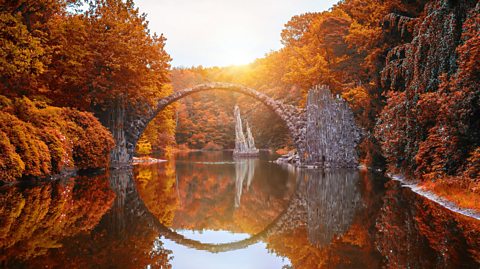
Four iconic maiden journeys in history
Looking back on some historical first voyages over land, air and sea.
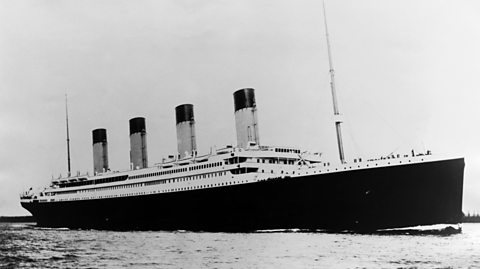
Six of the worldÔÇÖs most amazing railway journeys
From the highest railway to one of the longest, these aren't any ordinary train journeys.
